|
Iceberg Ice
When put in water, iceberg ice makes a cracking sound.
The temperature difference makes the ice melt and the sound stops eventually.
Everyone says it's great to drink whiskey with a piece of iceberg (unfortunately I haven't tried it yet).
I placed the ice water in the fridge and found next morning the ice remained floating on the water.
I was told iceberg has a tightly bounded molecule structure, so it is hard to melt.
To go out with an icebox full of ice chunks and have cold,
fresh water with the ice is a treat that is readily available in Greenland.
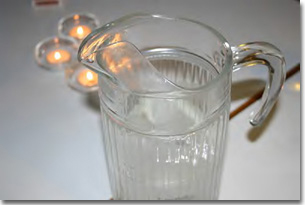
Water with a piece of iceberg
Puilasoq - Blessing From A Spring
Going for a night drive is one of the favorite leisure activities in Narsarsuaq.
I had two occasions where I was invited by two families to their night drives.
Each time, we drove around Narsarsuaq first and then went to Puilasoq.
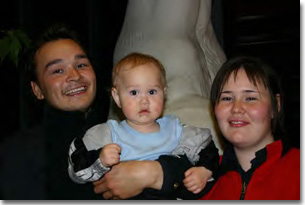
|
|
Tom-Erik, Malik, and Louise who I went for a drive with.
Louise is a 21-year-old mother.
Tom-Erik and Louise are not married but living together.
It is not unusual in Greenland, especially for the younger generation.
|
Puilasoq is a natural spring of groundwater located on a hillside.
Stones lay at the bottom of shallow water, and fresh,
crystal-clear water bubbles from the ground.
Whether driving or walking,
people come here with a plastic bottle or tank to draw water from the spring.
The water was very clear and I could see through to the stones on the bottom.
I scooped water and drank it. It was smooth, delicious, soft water.
This spring water, available even in winter of -20 degrees Celsius,
is a precious water source for the people in Narsarsuaq.
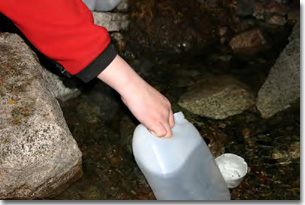
Scooping water at Puilasoq
Qivittoq, A Legend In Greenland
There was a night when Jacky and Birgitte stayed out and I was alone at the youth hostel.
Aima worried about me and asked me if I was afraid of ghosts.
I asked the same of her, "What about you? Are you scared of ghosts?
Are there ghosts in Greenland?"
Then Aima told me a story of Qivittoq.
According to Aima, Qivittoq lives high up in the mountains, runs like a wind,
he can communicate with animals and spirits.
He has long hair, a mustache, a beard, and wears clothes made of animal skin.
Qivittoq was once a human male, but one day he left his village and went to the mountains,
there, he acquired a special power. Bertha, Aima's mother,
told me that he became a hermit out of a tremendous grief and anguish over a lost love:
the girl he loved dearly deserted him and married another man.
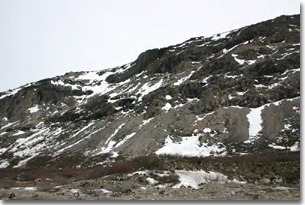
A mountain range in Narsarsuaq, Qvitoq might be hiding somewhere?
When I told Birgitte that I would want to know more about Qivittoq,
she introduced me to a Greenlandic film called "Qaamamgup uummataa (Light of Heart)".
It's a story about a man disillusioned with everything,
leaves for the mountain where he meets Qivittoq,
grasps something important, and finally returns to society.
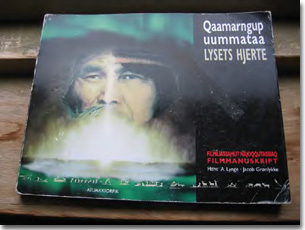
A movie script
The man on the front cover is Qvitoq in the movie
I feel Qivittoq is not really a ghost,
but rather a monster similar to a long-nosed goblin and ogre of Japanese fork tale.
I have brought three books with me in Greenland (It was quite tough choice I had to make).
One of them is "Oni No Kenkyu (Research on Ogres)" by Akiko Baba.
The book, which is heavily underlined by red pen, has been my favorite for almost ten years.
The book, introducing various Japanese traditions and classics, talks about Japanese cultures and natural phenomena and explains how the legend of ogres originated.
The author especially pursues human turned ogres.
According to the book, various feelings and experiences such as animosity, anger,
and humiliation makes a human turn into an ogre.
A strong emotion gives one energy to become an ogre.
Stories, legends, and songs passed by word of mouth from generation to generation eloquently convey the Inuit's way of life,
view of the world, view of nature, and relationship with animals.
At the same time, it functions like Aesop's Fables in the west passing down social norms and lessons to the next generation.
As I travel south, west, east, and north,
I am excited to hear about the various oral traditions of Greenland.
Noriko Miyashita
|



